Paddle Board Yoga – A Beginners Guide
Paddle board yoga (or SUP yoga) is a relatively new form of mind and body fitness training that combines the techniques and great benefits of both paddle boarding and yoga.
While it may seem at first to be an unlikely pairing, more and more people are opting to give it try in their quest for mind and body enrichment. If the current trajectory continues, SUP yoga may very well be on the way to becoming a mainstream practice.
Is this paddle board yoga guide for you?
Whether you have already tried either paddle boarding or yoga or are completely new to both, our paddle board yoga guide has got you covered. It will get you up to speed with all you need to know about this awesomely rewarding activity. If you’re new to the sport, our beginners guide to paddle boarding should get you up to speed. Or if you’re thinking about getting your first inflatable, our iSUP beginners guide has your covered.
What is paddle board Yoga?
Paddle board yoga is so much more than the sum of its parts, but we can get a good first understanding of it if we look quickly at the two activities that have merged to produce the new activity.
Stand Up Paddle boarding (SUP) can be done while sitting, kneeling, lying or standing on a paddle board, and using your arms or a paddle to move through the water. Yoga, on the other hand, is a set of poses and stretches combined with controlled breathing which are aimed towards having beneficial spiritual, physical and mental effects.
Paddle board yoga, therefore, is what you get when you sit, kneel, stand or lie on a floating paddle board to perform yoga routines.
So, what do you really end up with when you combine the two? An amazing boost in the benefits of both – that’s what! As the board floats and bobs gently up and down, your muscles have to work harder to help you achieve and maintain each pose.
What Does SUP Yoga Mean?
Quite often, the terms “paddle boarding” and “stand up paddle boarding (SUP)” are used interchangeably, referring in particular to standing on a board similar, but bigger than, a regular surfboard.
Hence the term “SUP yoga” is actually another way of saying paddle board yoga.
Why is Paddle Board Yoga Gaining in Popularity?
SUP has a wide range of benefits including that it is calorie-burning and muscle-building at the same time. Additionally, it gives your entire body a low impact workout but is particularly good for targeting and strengthening core muscles of the abdomen and back. Since it is done outside, in the water and in the fresh air, SUP is felt to also have the mental health benefits of relaxation and stress relief. See our guide Is Paddle Boarding Healthy? for a more exhaustive explanation of SUP health benefits.
Yoga’s benefits are actually quite similar to those of paddle boarding. It strengthens all the major muscle groups in the body while building balance and flexibility as well as improving posture. Mentally, the practice of yoga helps to relax and focus the mind, leaving you thinking clearer and more able to cope with the everyday stresses of life.
Now, put all those benefits together and it’s easy to see why so many people are making SUP yoga a part of their healthy lifestyle. People who try it are so pleased with the results that they readily encourage others to jump on board (pun intended!).
Increasing its popularity, is the fact that while you can do SUP yoga on an ordinary paddle board, there are boards specially constructed to give you maximum results from your routines. We’ll take a closer look at SUP yoga boards soon.
Paddle Board Yoga Poses
As a beginner of SUP yoga, you will want to start off slowly – even if you had already been doing yoga or SUP. Maintaining your balance is key. To avoid tilting the board, try to keep in line with the handle, as this marks the board’s center of balance. You can also maintain your balance by fixing your gaze on the horizon or on a point on land.
Here are 10 popular SUP yoga poses. Of course, some are more advanced than others and will require that you master other poses first before moving on to them. The important thing is to train with a certified instructor and never try poses you are not ready for or are uncomfortable with.
Keep at practising your routines regularly – before you know it you’ll be mastering all your poses!
1. Side Plank
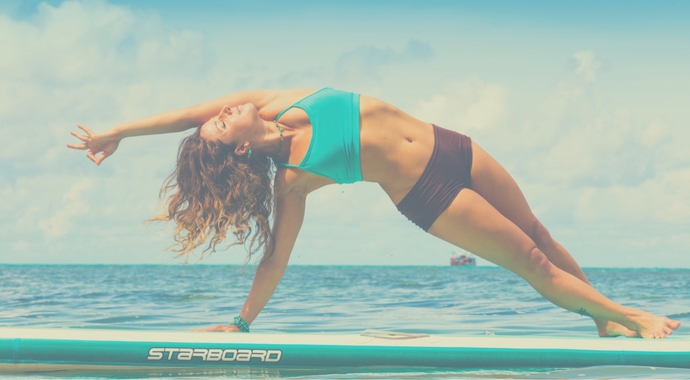
The side plank pose begins in the plank position (facing the board and raised up onto flat palms and toes). You then shift your weight onto one hand, rotate your torso and raise the other arm up from the board. To achieve this side plank variation, cross your legs with the lower leg over and in front of the upper leg.
2. Crescent Lunge
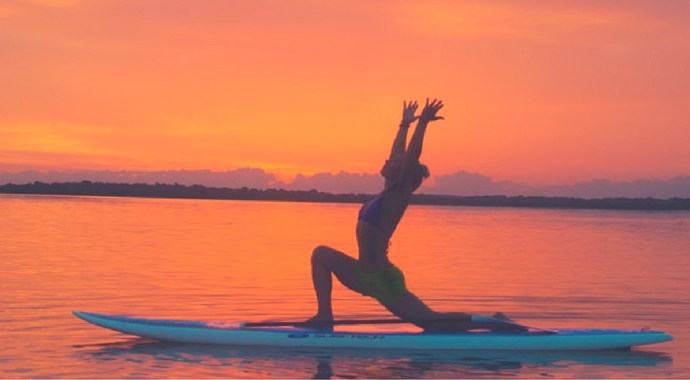
Start off in the downward-facing dog position then step one foot forward between your hands. Bend the front knee to 90 degrees with the knee directly over the heel. Rise onto the ball of the back foot with the heel directly over the toes. Lower the knee of the back leg to the board and rest the top of the foot on the board. Raise your arms with hands parallel over your head as you arch your back and look up.
3. Warrior Pose
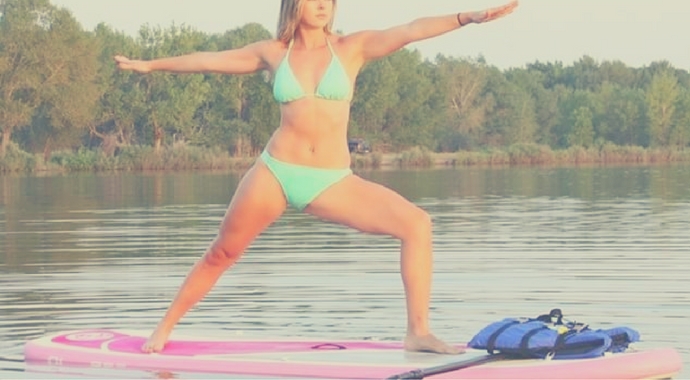
Stand with legs wide apart and rotate the right foot out 90 degrees and the left foot slightly inward. Lift your arms out to the side with the palms down. Bend the right knee to 90 degrees and over your toes. Turn your head to the right.
4. Three-legged Downward-Facing Dog
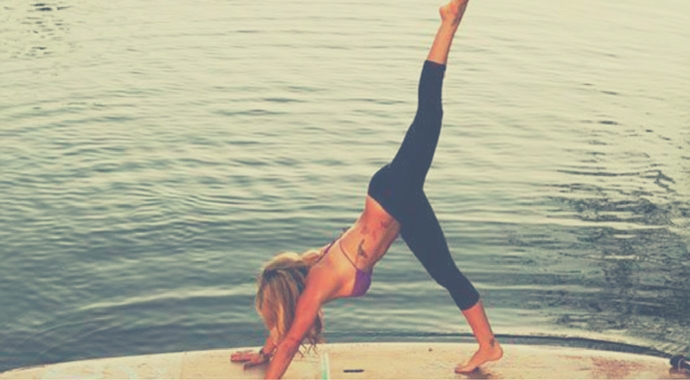
Transform the downward-facing dog pose by extending one leg straight back and up. Ensure there is no rotation in your hip, by keeping it square with the board.
5. Tree Pose on Left Leg
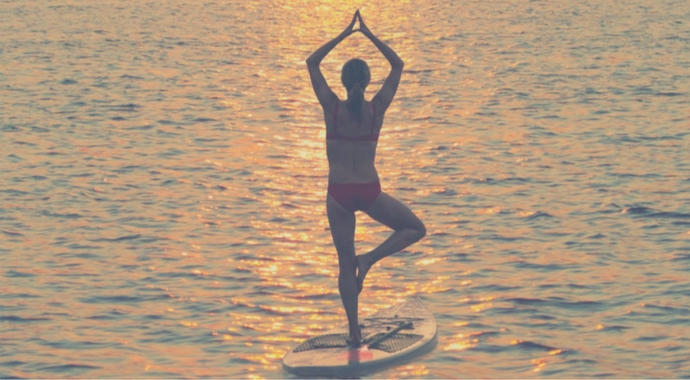
Stand straight with the right foot placed firmly on the board. Bend the left knee and put the left foot to the inner side of the right thigh. Once you feel balanced, raise your hands to your chest in Namaste (palms together). Balance again then raise the hands, still in Namaste, over your head.
6. Upward-Facing Dog
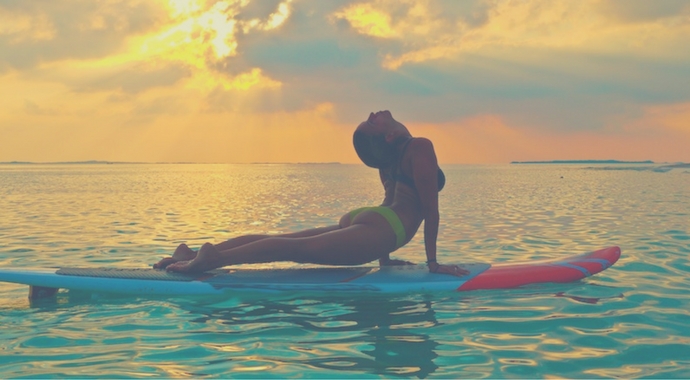
Assume the plank position. Bend your arms as you lower your pelvis and thighs to just above the board. Keep your arms and legs straight as you arch your back and look forward.
7. Headstand Lotus
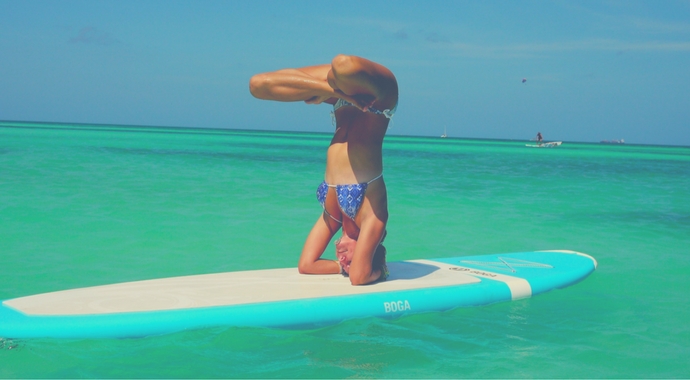
Mastering the classical headstand is vital before attempting this beautiful headstand lotus advanced pose. From the classical headstand you bend one leg and place it on the opposite thigh then repeat with the other leg.
8. Camel Pose
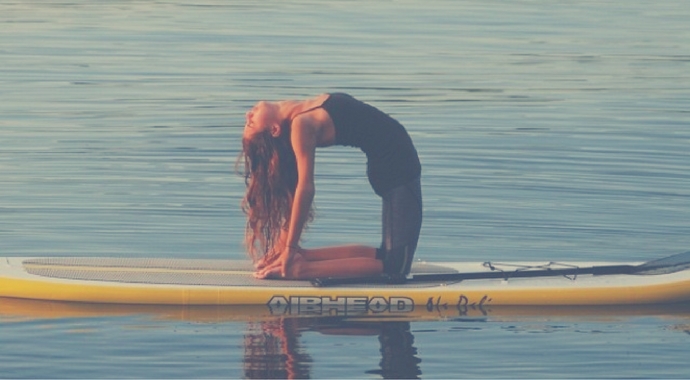
Sit on your heels then lift your thighs and your pelvis up and forward. Press your palms against the soles of your feet as you arch your back with your head thrown back.
9. One-Legged King Pigeon: Left Foot Grab
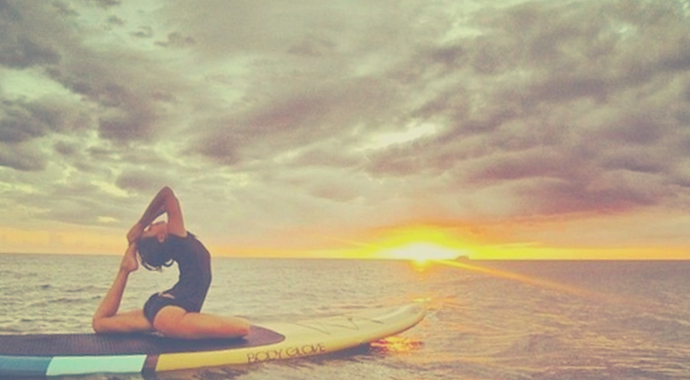
You begin this pose in downward-facing dog position. Step the right foot forward, resting the right thigh and knee on the board. As you press your hands into the board, arch softly and bend your left leg. Keeping your elbows up, grab your left toes from above. Pull the shin back, arch some more and look straight ahead.
10. Hollow Back Wheel
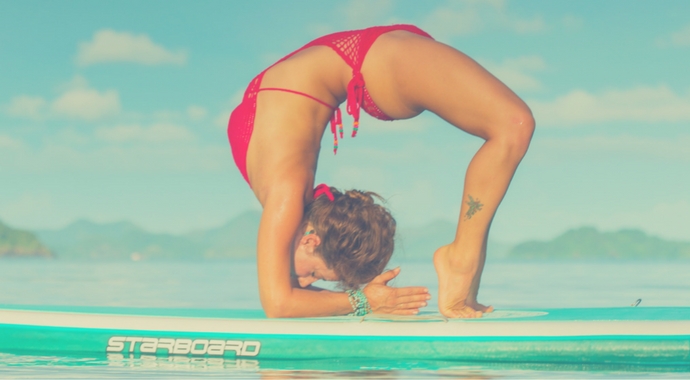
This is an advanced pose that is best performed after you have mastered the wheel pose. Start off in the wheel position then lower yourself onto your elbows, one at a time. Keep your forearms on the board, your hands clasped with palms together and lift up your heels.
Yoga Video of Dashama showing different poses
Dashama runs through various SUP yoga poses in this video. This video is not meant to be instructional, but rather to give you a glimpse into some of the possible poses to work towards.
SUP Yoga Equipment
When you do paddle board yoga, the floating board becomes your mat. First off, we’ll take a close look at what your SUP yoga board should be like. Aside from a board, however, there are a few other items that will ensure you get the most out of each session.
The Paddle Board – SUP or iSUP
You can either purchase a paddle board specifically designed for performing yoga on, or if you are unsure whether it’s for you, or you don’t intend to use the board regularly, then you can choose a regular paddle board before potentially moving onto a speciality SUP yoga board. For most, a board that is of medium length (about 9 feet to 12 feet long) and wide will offer more stability and make standing and moving easier.
SUP boards are generally either an EPS core that is wrapped with fiberglass and epoxy, or an inflatable paddle board made from lightweight polyurathene with drop-stich construction. Inflatable boards are filled with air using a pump and can be deflated, rolled to the size of a sleeping bag, and transported anywhere. The technology of both board types has come a long way in recent years.
Benefits of Specialist SUP Yoga Boards
Sup yoga boards are designed for maximum stability and safety as you move around on them. Generally, they are about 30-36 inches wide and have a higher volume than regular boards. Some SUP yoga boards have a flatter, softer deck pad making them more comfortable than boards made of fiberglass.
The amount of “grip” the deck offers is also important to lower the chances of you falling off as you get into and out of your yoga poses. Ideally, the front or nose of the deck should be designed wider since some poses require more space for foot and hand placement. Downward dog, for example, needs you to have your hands far apart.
Consider an Inflatable Board for SUP Yoga
Hard, bulky and heavy conventional SUP boards can pose significant transportation and storage issues, especially for beginners that may not be ready for such a commitment. Inflatable paddle boards, offer a great alternative. Here’s why:
Easy on the joints
Since they are filled with air, they offer more cushioning to your joints as you move.
Offer a softer landing spot
If you tumble mid-pose and manage not to fall in the water, then it is much more pleasant to land on an iSUP’s soft surface than on the harder surface of other boards.
Convertible and compact
iSUPs have the ability to fold right down to the size of a sleeping bag and then inflate into a full-sized board. When folded you can always take them along with you regardless of if you have a small car, choose to take public transport, or fancy taking your SUP globetrotting with you. The folded iSUP can also easily be stored practically anywhere.
Lightweight
No big bulging muscles are required to get your iSUP from the car to the beach. By using iSUPs, more people now have the opportunity to do SUP yoga than if they had to use a heavier board.
Durability and rigidity
If you practice yoga daily then you don’t need to worry about wear and tear on your board. iSUPs are made of strong material, usually PVC and epoxy, and have a high tensile drop-stitch composite for rigidity. So while they can bend without breaking, they will also not sag in the middle and take on water.
The downsides of iSUPs for Yoga
The only real downside is that you’ll need to pump up and deflate your board each time you use it, adding 5-10 minutes to your SUP yoga routine. 10 minutes may not sound like a lot, but it can make a difference if you are trying to sneak in a morning session before work. Some of this time can be offset by the extra convenience – ie time save by not having to take the hard board to the car/truck, strapping it on, taking it off and transporting it to the water.
Other SUP Yoga Equipment
Apart from the board, SUP yoga will require that you have a few accessories that will make your session safer and more comfortable. These include:
- An anchor to ensure your board stays in safe water and does not float away
- A leash or tie of some sort that you can use to secure your paddle while you perform your routines. This is also good for holding your must-have water bottle.
- A water bottle with fresh water or a healthy drink to ensure you stay hydrated
- Sunscreen to keep your skin protected. Some also like to wear a cap for extra sun protection.
What to Wear to SUP Yoga
Your choice of outfit will definitely depend on the weather and how comfortable you are moving in each item of clothing. You will find it very distracting if you constantly have to be tugging at something to get it back in place. Women, more so than men, who do SUP yoga tend do be particularly mindful of this. A quick tip is to put on your outfit and practice some of your stretches and bending in front of the mirror first before wearing them to a session.
Swimwear
For women, bikinis and one piece suits are both quite okay. If you wear a bandeau top, however, it is wise to attach the halter strap. A skirt or a pair of shorts can help keep you modest as you do certain poses – think downward-facing dog, for example. Men will find a pair of shorts and swim trunks are ideal.
Workout clothes
While your swimsuit alone will do on a hot day, it is often recommended that you add leggings or cropped workout pants on bottom. On top, you could layer on a T-shirt, rashguard or tank top over your swim suit or sports bra.
We hope that this guide has given you enough inspiration to get out there and give SUP yoga a try. Remember, go at your own pace and enjoy the freedom on offer.
If you’re still undecided about paddle boarding in general, feel free our Beginners Guide to Paddle Boarding. Happy paddling!




